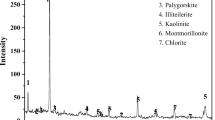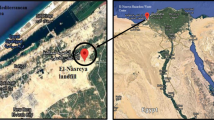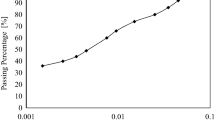Abstract
In this work, geotechnical properties of heavy-metal contaminated soil consist of basic properties, strength, leaching, electrical resistivity and microstructural characteristics were investigated. The results showed that the clay content, specific surface area and cation exchange capacity of the soil decreased as heavy-metal concentrations increased. The decrease in basic properties was more significant in Zn-contaminated soil than that in Pb-contaminated soil. The unconfined compressive strength (UCS) decreased as heavy-metal concentrations increased. The effect of Zn2+ on UCS was confirmed to be greater than that of Pb2+. The leached heavy-metal concentration increased with higher initial heavy-metal concentrations. A greater leaching capacity was observed in Zn-contaminated soil compared to Pb-contaminated soil. With increasing pore fluid resistivity, UCS values gradually increased and leached ion concentrations dramatically decreased before becoming stable. Zn-contaminated soil was found to have a lower strength and higher leached-ion concentration than Pb-contaminated soil. A set of equations was proposed to successfully predict the engineering properties of contaminated soil using pore fluid resistivity. Microstructural analysis presented that, as heavy-metal concentrations increased, clay particles aggregated, the flocculation structure and the inter-aggregate pores became enlarged. Zn-contaminated soil had larger aggregate and inter-aggregate pores, compared to Pb-contaminated soil. In general, significant effects of heavy metal ions on geotechnical properties of the contaminated soil have been revealed and analyzed in the present work, which could be predicted using the pore fluid resistivity in a more effective way.










Similar content being viewed by others
References
Alloway BJ (2015) Heavy metals in soils. Mineral Mag 55(8):1318–1324
Archie GE (2013) The electrical resistivity log as an aid in determining some reservoir characteristics. Well Logging Technol 146(3):54–62
ASTM D2166-06 (2006) Standard test method for unconfined compressive strength of cohesive soil. American Society for Testing and Materials, West Conshohocken, Pa
ASTM (2011) Standard practice for classification of soils for engineering purposes (unified soil classification system). ASTM (American Society for Testing and Materials), West Conshohocken, PA (D2487)
Bradl HB (2004) Adsorption of heavy metal ions on soils and soils constituents. J Colloid Interface Sci 277(1):1–18
Burakov AE, Galunin EV, Burakova IV, Kucherova AE, Agarwal S, Tkachev AG, Gupta VK (2017) Adsorption of heavy metals on conventional and nanostructured materials for wastewater treatment purposes: a review. Ecotoxicol Environ Saf 148:702–712
Chen YG, Jia LY, Ye WM, Wang Q, Chen B, Cui YJ (2015) Infiltration of Pb(II) solution in compacted bentonite/sand mixture under unconfined conditions. Ecotoxicol Environ Saf 74(7):6137–6145
Chu S, Wu D, Liang LL, Zhong F, Hu Y, Hu X, Lai C, Zeng S (2017a) Municipal sewage sludge compost promotes Mangifera persiciforma tree growth with no risk of heavy metal contamination of soil. Sci Rep 7(1):13408
Chu Y, Liu S, Wang F, Cai G, Bian H (2017b) Estimation of heavy metal-contaminated soils’ mechanical characteristics using electrical resistivity. J Appl Geophys 24(15):13561–13575
Chu Y, Liu, SY, Cai GJ, Bian HL, Zhang T (2016) Physical and microscopic characteristics experiments with heavy metal polluted cohesive soil. Geo-Chicago, ASCE. Chicago, pp 42–52
Deng YF, Liu QW, Cui YJ, Wang Q, Liu SY (2019) Revisiting relationships among specific surface area, soil consistency limits, and group index of Clays. J Test Eval 47(2):20170257
Du YJ, Wei ML, Reddy KR, Wu HL (2016) Effect of carbonation on leachability, strength and microstructural characteristics of KMP binder stabilized Zn and Pb contaminated soils. Chemosphere 144(FEB.):1033–1042
Du YJ, Jiang NJ, Liu SY, Singh DN (2014) Engineering properties and microstructural characteristics of cement-stabilized zinc-contaminated kaolin. Can Geotech J 51(3):289–302
Du YJ, Jin F, Liu SY, Chen L, Zhang F (2011) Review of stabilization/solidification technique for remediation of heavy metals contaminated lands. Rock Soil Mech 32(1):116–124
Dutta J, Mishra AK (2016) Influence of presence of heavy metals on the behaviour of bentonites. Environ Earth Sci 75(11):1–10
EPA US (1994) Method 1311: toxicity characteristic leaching procedure. In: EPA SW-846: test methods for evaluating solid waste, physical/chemical methods, 3rd edn. Envirnmental Protection Agency, Washington, DC
Feng SJ, Bai ZB, Cao BY, Lu SF, Ai SG (2017) The use of electrical resistivity tomography and borehole to characterize leachate distribution in Laogang landfill, China. Environ Environ Sci Pollut Res 24(25):20811–20817
Gajo A, Maines M (2007) Mechanical effects of aqueous solutions of inorganic acids and bases on a natural active clay. Geotechnique 57:687–699
Ghorbel-Abid I, Trabelsi-Ayadi M (2015) Competitive adsorption of heavy metals on local landfill clay. Arab J Chem 8(1):25–31
Griffin RA, Shimp NF, Steele JD, Ruch RR, White WA, Hughes GM (1976) Attenuation of pollutants in municipal leachate by passage through clay. Environ Sci Technol 10:1262–1268
Heike BB (2004) Adsorption of heavy metal ions on soils and soils constituents. J Colloid Interface Sci 277:1–18
Japanese Geotechnical Society (2000) Soil and foundations, pp 65–67
Jozja N, Baillif P, Touray JC, Pons CH, Muller F, Burgevin C (2003) Impacts «multiéchelle » d’un échange (Mg, Ca)-Pb et ses conséquences sur l’augmentation de la perméabilité d’une bentonite. C R Geosci 335:729–736
Jullien A, Proust Ch, Le Forestier L, Baillif P (2002) Hydro-chemio-mechanical coupling effects on permeability and swelling behaviour of a Ca smectite soaked by Cu solutions. Appl Clay Sci 21:143–153
Khalid S, Shahid M, Niazi NH, Murtaza B, Bibi I, Dumat C (2017) A comparison of technologies for remediation of heavy metal contaminated soils. J Geochem Explor 182:247–268
Khamehchiyan M, Charkhabi AH, Tajik M (2007) Effects of crude oil contamination on geotechnical properties of clayey and sandy soils. Eng Geol 89(3–4):220–229
Kibria G, Hossain S, Alam Z (2014) A statistical model based on experimental results: correlating electrical resistivity with geotechnical properties of clayey soils. In: Transportation research board 93rd annual meeting (no 14-1722)
Laporte-Saumure M, Martel R, Mercier G (2011) Characterization and metal availability of copper, lead, antimony and zinc contamination at four Canadian small arms firing ranges. Environ Technol 32(7):767–781
Li JS, Xue Q, Wang P, Li ZZ (2015) Effect of lead(II) on the mechanical behavior and microstructure development of a Chinese clay. Appl Clay Sci 105–106:192–199
Liu SY, Du YJ, Chen L, Liu ZB, Jin F (2010) Application of electrical resistivity for cement solidified/stabilized heavy metal contaminated soils. In: Chen Y, Zhan L, Tang X (eds) Advances in environmental geotechnics. Springer, Berlin, Heidelberg, pp 259–264. https://doi.org/10.1007/978-3-642-04460-1_18
Liu JJ, Zha FS, Xu L, Yang CB, Chu CF, Tan XH (2018) Effect of chloride attack on strength and leaching properties of solidified/stabilized heavy metal contaminated soils. Eng Geol 246:28–35
Liu JJ, Zha FS, Xu L, Kang B, Tan XH, Deng YF, Yang CB (2019) Mechanism of stabilized/solidified heavy metal contaminated soils with cement-fly ash based on electrical resistivity measurements. Measurement 141:85–94
Liu ZB, Ma X, Dai WL (2011) Experimental research on engineering property of heavy metal-contaminated kaolinite. Appl Mech Mater 94–96:921–1929
Morvan M, Espinat D, Lambard J, Zemb Th (1994) Ultrasmall- and small-angle X-rayscattering of smectite clay suspensions. Colloids Surf A Physicochem A Physicochem Eng Asp 82(2):193–203
Ouhadi VR, Yong RN (2003) Impact of clay microstructure and mass absorption coefficient on the quantitative mineral evaluation by XRD analysis. Appl Clay Sci 23(1–4):141–148
Ouhadi VR, Yong RN, Sedighi M (2006) Desorption response and degradation of buffering capability of bentonite, subjected to heavy metal contaminants. Eng Geol 85(1–2):102–110
Ouhadi VR, Yong RN, Rafiee F, Goodarzi AR (2011) Impact of carbonate and heavy metals on micro-structural variations of clayey soils. Appl Clay Sci 52(3):0–234
Pansu M, Gautheyrou J (2006) Handbook of soil analysis-mineralogical, organic and inorganic methods. Springer, Heidelberg
Powers SE, Anckner WH, Seacord TF (1996) Wettability of NAPL contaminated sands. J Environ Eng 122:889–896
Rao SN (1995) Effects of exchangeable cations on hydraulic conductivity of a marine clay. Clays Clay Miner 43(4):433–437
Souli H, Fleureau JM, Ayadi MT, Besnard M (2008) Physicochemical analysis of permeability changes in the presence of zinc. Geoderma 145(1–2):1–7
Tang CS, Wang DY, Zhu C, Zhou QY, Xu SK, Shi B (2018) Characterizing drying-induced clayey soil desiccation cracking process using electrical resistivity method. Appl Clay Sci 152:101–112
Tiwari B, Tuladhar GR, Marui H (2005) Variation in residual shear strength of the soil with the salinity of pore fluid. J Geotech Geoenviron Eng 131:1445–1456
Uddin MK (2016) A review on the adsorption of heavy metals by clay minerals, with special focus on the past decade. Chem Eng J 308:438–462
Wahid AS, Gajo A, Di Maggio R (2011) Chemo-mechanical effects in kaolinite. Part l: prepared samples. Geotechnique 61:439–447
Wang F, Wang H, Al-Tabbaa A (2014) Leachability and heavy metal speciation of 17-year old stabilised/solidified contaminated site soils. J Hazard Mater 278:144–151
Wang YZ, Chen YM, Xie HJ, Zhang CH, Zhan LT (2016) Lead adsorption and transport in loess-amended soil-bentonite cut-off wall. Eng Geol 215:69–80
Wu H, Hu L (2014) Microfabric change of electro-osmotic stabilized bentonite. Appl Clay Sci 101:503–509
Xie HJ, Chen YM, Zhan LT, Chen RP, Tang XW, Chen RH, Ke H (2009) Investigation of migration of pollutant at the base of Suzhou, Qizishan landfill without a liner system. J Zhejiang Univ Sci A 10(3):439–449
Xu P, Wu C (2014) Analysis of soil heavy metals pollution and its present situation around lead-zinc mining areas in China. Adv Environ Prot 4(5):187–194 ((in Chinese))
Yong RN (2001) Geoenvironmental engineering, contaminated soils, pollutant fate and mitigation. CRC Press, Boca Raton, p 307
Yong RN, Ouhadi VR, Goodarzi AR (2009) Effect of Cu2+ ions and buffering capacity on smectite microstructure and performance. J Geotech Geoenviron Eng 135(12):1981–1985
Yoon GL, Park JB (2001) Sensitivity of leachate and fine contents on electrical resistivity variations of sandy soils. J Hazard Mater 84:147–161
Zha FS, Ji CJ, Xu L, Kang B, Yang CB, Chu CF (2019) Assessment of strength and leaching characteristics of heavy metal–contaminated soils solidified/stabilized by cement/fly ash. Environ Sci Pollut Res 26:30206–30219
Zhang D, Cao Z, Fan L, Liu S, Liu W (2014) Evaluation of the influence of salt concentration on cement stabilized clay by electrical resistivity measurement method. Eng Geol 170:80–88
Acknowledgements
This work was supported by the National Natural Science Foundation of China (Grant numbers: 41807239, 41877262, 41672306), the Special Project for Major Science and Technology in Anhui Province, China (Grant number: 18030801103), the Fundamental Research Funds for the Central Universities, China (Grant number: JZ2020HGTB0055) and the National Key Research and Development Plan of China (Grant number: 2019YFC1509903).
Author information
Authors and Affiliations
Corresponding author
Ethics declarations
Conflict of interest
On behalf of all authors, the corresponding author states that there is no conflict of interest.
Additional information
Publisher's Note
Springer Nature remains neutral with regard to jurisdictional claims in published maps and institutional affiliations.
Rights and permissions
About this article
Cite this article
Zha, F., Zhu, F., Xu, L. et al. Laboratory study of strength, leaching, and electrical resistivity characteristics of heavy-metal contaminated soil. Environ Earth Sci 80, 184 (2021). https://doi.org/10.1007/s12665-021-09451-7
Received:
Accepted:
Published:
DOI: https://doi.org/10.1007/s12665-021-09451-7




